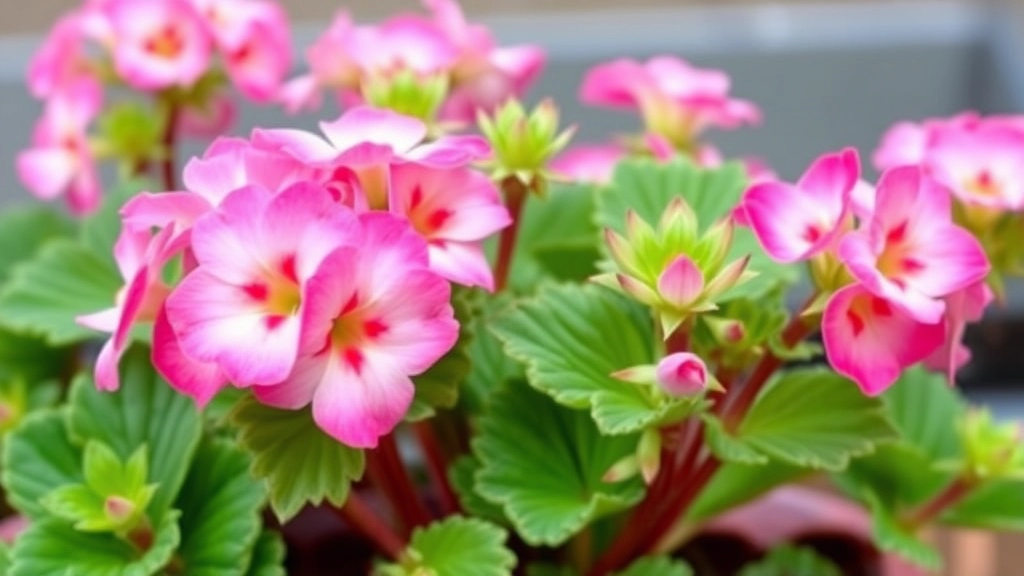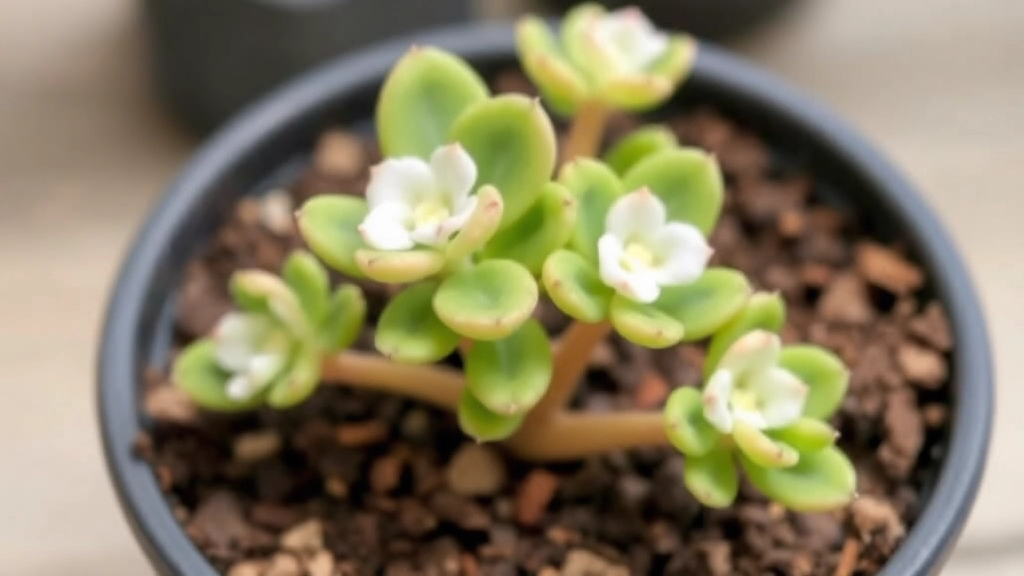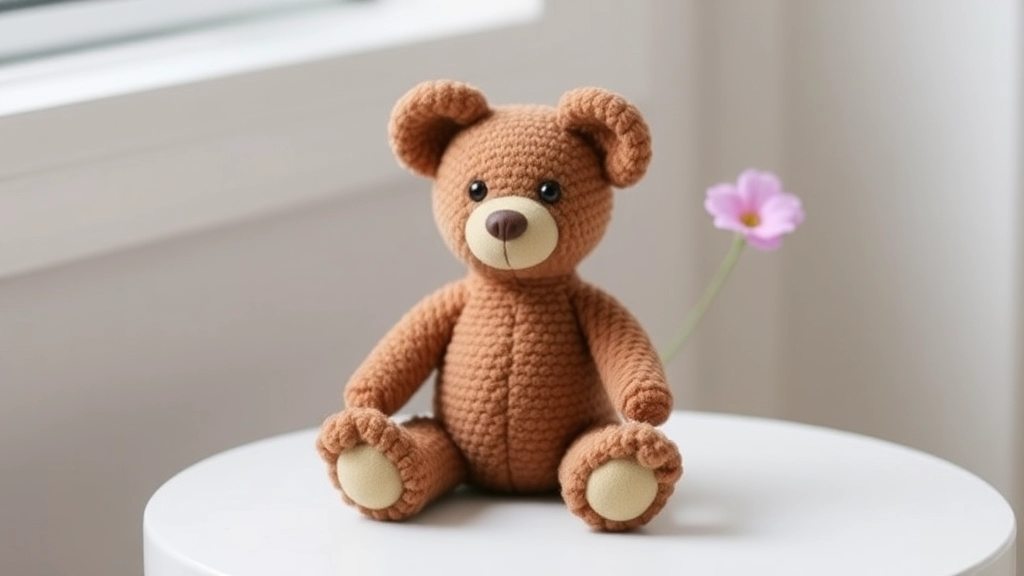Kalanchoe ‘Naked Teddy Bear’
If you’re looking for a unique and charming addition to your succulent collection, the Kalanchoe ‘Naked Teddy Bear’ might just be the perfect fit. This delightful plant stands out with its fuzzy, teddy bear-like leaves that add a touch of whimsy to any space. In this article, we’ll dive into the unique features of the Kalanchoe ‘Naked Teddy Bear’ and explore the best conditions for growing this adorable succulent.
Care and Maintenance
To keep your Kalanchoe ‘Naked Teddy Bear’ thriving, it’s crucial to understand its specific watering and care needs. We’ll provide you with essential tips on how to water and maintain a healthy plant, along with propagation methods to expand your collection.
Pest Management
Plus, we’ll cover common pests and how to manage them, ensuring your succulent remains in top shape.
Decorating with Kalanchoe ‘Naked Teddy Bear’
Finally, discover creative ways to decorate your space with the Kalanchoe ‘Naked Teddy Bear’, making it a standout feature in your home or garden.
Unique Features of the Kalanchoe âNaked Teddy Bear’
Are you curious about what makes the Kalanchoe âNaked Teddy Bear’ a standout choice for succulent lovers?
This delightful plant boasts several unique features that set it apart from other succulents.
Distinctive Appearance
The Kalanchoe âNaked Teddy Bear’ is known for its fuzzy, velvety leaves, which resemble the soft fur of a teddy bear.
- Leaf Texture: The leaves are covered in tiny hairs, giving them a unique tactile quality.
- Shape: They have a rounded, plump shape that adds to their charm.
- Colour: The leaves typically display a vibrant green hue, often with hints of red along the edges when exposed to sunlight.
These features not only make the plant visually appealing but also create an inviting texture that encourages touch.
Compact Growth Habit
Another remarkable aspect of the Kalanchoe âNaked Teddy Bear’ is its compact growth.
- Size: This succulent typically grows to about 30 cm tall, making it an ideal choice for small spaces.
- Form: Its bushy, upright form adds a playful touch to any collection.
This compact nature means you can easily incorporate it into your home without worrying about it taking over.
Resilience and Hardiness
The Kalanchoe âNaked Teddy Bear’ is also known for its resilience.
- Drought Tolerance: Like most succulents, it thrives in dry conditions, making it perfect for busy individuals.
- Low Maintenance: This plant requires minimal care, allowing you to enjoy its beauty without constant attention.
These traits make it an excellent choice for both novice and experienced gardeners alike.
For more insights on other Kalanchoe varieties, check out our Kalanchoe Teddy Bear Care and Propagation Guide and our detailed Kalanchoe Tomentosa Care Tips and Growing Guide.
Best Conditions for Growing Kalanchoe ‘Naked Teddy Bear’

So, you’ve got your Kalanchoe ‘Naked Teddy Bear’ and you’re wondering how to give it the best home possible?
Let’s dive into the ideal conditions for this charming succulent.
Light Requirements
- Bright, Indirect Light: Kalanchoe ‘Naked Teddy Bear’ thrives in bright, indirect sunlight.
- Avoid Harsh Sun: Too much direct sun can scorch those lovely leaves.
Temperature and Humidity
- Warm Temperatures: Aim for a temperature range of 20°C to 25°C (68°F to 77°F).
- Low Humidity: This plant prefers drier air, so keep it away from overly humid spots.
Soil Preferences
- Well-Draining Soil: Use a cactus or succulent mix to prevent root rot.
- pH Level: A slightly acidic to neutral pH is ideal.
Potting Considerations
- Terracotta Pots: These help wick moisture away from the roots, which is a huge plus.
- Size Matters: Choose a pot that’s just slightly bigger than the root ball to avoid excess moisture.
Watering and Care Tips for a Healthy Kalanchoe âNaked Teddy Bear’
When it comes to keeping your Kalanchoe âNaked Teddy Bear’ thriving, watering and care are crucial. Many plant enthusiasts often worry about overwatering or underwatering their succulents.
Propagation Methods for the Kalanchoe ‘Naked Teddy Bear’

Many enthusiasts wonder how to propagate their Kalanchoe ‘Naked Teddy Bear’ effectively.
This unique succulent can be multiplied through several straightforward methods that ensure you maintain its charming features.
Leaf Cuttings
One of the simplest ways to propagate your Kalanchoe is through leaf cuttings. Here’s how to do it:
- Select a Healthy Leaf: Look for a plump, healthy leaf on your plant.
- Cut the Leaf: Use a clean, sharp knife or scissors to cut the leaf at its base.
- Let it Callous: Place the leaf in a dry, shaded area for a few days. This allows the cut end to callous over, reducing the risk of rot.
- Plant the Leaf: Once calloused, place the leaf on well-draining soil. You can lightly press it into the soil but don’t bury it.
- Water Sparingly: Mist the soil lightly and avoid overwatering. New roots will develop in a few weeks.
Offsets
Kalanchoe plants often produce offsets, or “pups,” which are perfect for propagation.
- Identify Offsets: Look for small plants growing at the base of the main plant.
- Remove Offsets: Gently twist or cut the offset away from the parent plant.
- Let it Callous: Similar to leaf cuttings, allow the offset to dry for a few days.
- Plant the Offset: Place it in a well-draining potting mix and water lightly.
Seed Propagation
Though less common, propagating through seeds is another option.
- Collect Seeds: If your Kalanchoe flowers, you can collect the seeds once they mature.
- Prepare Soil: Use a seed-starting mix for optimal germination.
- Sow the Seeds: Scatter the seeds on the surface and lightly press them into the soil without covering them completely.
- Maintain Moisture: Keep the soil moist but not soggy until germination occurs, which can take several weeks.
Tips for Successful Propagation
- Lighting: Ensure your cuttings or offsets receive bright, indirect sunlight.
- Humidity: A humid environment can help, but avoid excessive moisture.
- Patience: Propagation takes time; be patient as your new plants develop.
By mastering these propagation techniques, you can easily expand your collection of Kalanchoe ‘Naked Teddy Bear’ and share them with friends or beautify your space.
As you nurture your Kalanchoe âNaked Teddy Bear’, you might find yourself worrying about pests that could jeopardize its health. Understanding the common pests that affect succulents is crucial for maintaining a thriving plant.
### Common Pests to Watch For
– **Aphids**
– Small, soft-bodied insects that cluster on new growth.
– They suck plant sap, leading to distorted leaves.
– **Mealybugs**
– White, cotton-like masses found in leaf axils and on stems.
– They can cause leaf drop and stunted growth.
– **Spider Mites**
– Tiny, spider-like creatures that create fine webbing.
– They thrive in dry conditions and can lead to yellowing leaves.
– **Fungus Gnats**
– Small flies that are attracted to moist soil.
– Their larvae can damage roots, leading to poor plant health.
### Management Strategies
To keep your Kalanchoe âNaked Teddy Bear’ free from pests, consider these effective management strategies:
– **Regular Inspection**
– Check your plant weekly for signs of pests. Early detection is key.
– **Natural Predators**
– Introduce beneficial insects like ladybugs or lacewings that feed on aphids and mealybugs.
– **Neem Oil**
– A natural pesticide that can be sprayed on affected areas to deter pests.
– **Insecticidal Soap**
– This is effective against soft-bodied insects like aphids and mealybugs.
– **Keep it Clean**
– Regularly dust the leaves and remove any dead or decaying plant material to reduce pest habitats.
– **Proper Watering**
– Overwatering can create a breeding ground for pests. Ensure the soil dries out between waterings.
For more detailed guidance on caring for Kalanchoe varieties, you might find our [Kalanchoe Chocolate Soldier Care Guide](https://planthq.org/kalanchoe-chocolate-soldier-care-guide-light-water-and-tips/) helpful. Additionally, if you’re dealing with specific leaf issues, our article on [Causes and Solutions for Black Spots on Kalanchoe Leaves](https://planthq.org/causes-and-solutions-for-black-spots-on-kalanchoe-leaves/) offers valuable insights.
Decorating Your Space with Kalanchoe âNaked Teddy Bear’
Have you ever looked around your space and thought it could use a little life?
Kalanchoe âNaked Teddy Bear’ is your answer!
This adorable succulent isn’t just a plant; it’s a statement piece.
Why Choose Kalanchoe âNaked Teddy Bear’?
Unique Appearance: Its fuzzy leaves and vibrant green colour add character.
Low Maintenance: Perfect for busy folks who want a bit of greenery without the fuss.
Versatile: Fits into various decor styles, from modern to rustic.
Where to Place Your Kalanchoe
Windowsills: They thrive in bright, indirect sunlight.
Shelves: Create a layered look with other plants.
Desk: A little green can boost your mood while you work.
Tips for Styling
Group Plantings: Pair with other succulents for a mini garden vibe.
Use Unique Pots: A quirky pot can elevate its charm. Think terracotta, ceramic, or even a vintage teacup!
Add Height: Use plant stands to create visual interest.
Creating a Focal Point
Center Stage: Make it the star of your coffee table.
Hanging Displays: Consider a macramé hanger to draw the eye upward.
Combine with Art: Place it near artwork or photos for a cohesive look. For more tips on styling your Kalanchoe, check out our [comprehensive pink Kalanchoe plant care guide](https://planthq.org/comprehensive-pink-kalanchoe-plant-care-guide/).
If you’re interested in exploring more varieties, don’t miss our guide on [top Kalanchoe varieties with pink edges](https://planthq.org/top-kalanchoe-varieties-with-pink-edges/).
Frequently Asked Questions (FAQs) about Kalanchoe ‘Naked Teddy Bear’
What are the light requirements for Kalanchoe ‘Naked Teddy Bear’?
Kalanchoe ‘Naked Teddy Bear’ thrives in bright, indirect sunlight. Avoid exposing it to harsh, direct sunlight as it can scorch the leaves.
What is the ideal temperature range for this plant?
This succulent prefers warm temperatures ranging from 20°C to 25°C (68°F to 77°F). It is essential to keep it in a relatively dry environment, away from overly humid spots.
What type of soil should I use for Kalanchoe ‘Naked Teddy Bear’?
Use a well-draining soil mix, such as a cactus or succulent potting mix, to prevent root rot. A slightly acidic to neutral pH is ideal for this plant.
What kind of pot is best for Kalanchoe ‘Naked Teddy Bear’?
Terracotta pots are recommended as they help wick moisture away from the roots. Ensure the pot is just slightly bigger than the root ball to avoid excess moisture retention.
How can I propagate Kalanchoe ‘Naked Teddy Bear’?
There are several methods to propagate this succulent:
Leaf Cuttings
Select a healthy leaf, cut it at the base, let it callous for a few days, and then place it on well-draining soil. Water sparingly.
Offsets
Look for small plants (offsets) at the base of the main plant, remove them gently, let them callous, and plant them in a well-draining mix.
Seed Propagation
Collect seeds from the flowers, prepare a seed-starting mix, sow the seeds on the surface, and maintain moisture until germination occurs.
What are some tips for successful propagation?
- Ensure cuttings or offsets receive bright, indirect sunlight.
- Avoid excessive moisture but maintain a slightly humid environment.
- Be patient as propagation takes time.
How often should I water Kalanchoe ‘Naked Teddy Bear’?
Water sparingly, allowing the soil to dry out between waterings. Overwatering can lead to root rot.
Can Kalanchoe ‘Naked Teddy Bear’ be grown indoors?
Yes, it can be grown indoors as long as it receives adequate bright, indirect light and is kept in a well-ventilated area to avoid excessive humidity.
References
-
Kalanchoe Plant Propagation
-
How to Grow Kalanchoe Succulents Indoors
-
Kalanchoe: How to Plant, Grow, and Care for Kalanchoe
